Muskrats in South Carolina
Management and Control
The habit of digging tunnels in the banks of ponds and streams causes conflict between man and muskrat. Muskrat dens dug into a farm pond dam could cause failure of the dam, and there is also danger of people and livestock breaking through the top of a tunnel and being injured. Riprap along the dam face can deter muskrats from burrowing into a dam. Riprap should be at least 3 feet below water level and extend to at least 1 foot above the water level. This technique can be used for dams that are already constructed as well as for ponds under construction. Water control devices in dams should have a concrete apron to prevent muskrat burrows from compromising these structures.
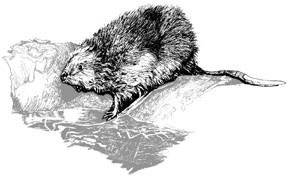
Adhering to a few simple rules when constructing a pond can minimize future muskrat damage to pond dams. The dam should have a minimum width of 20 feet at water level and be well sodded to bind the soil together. A gradual slope (3:1) on the inner or pond side of the dam and a spillway large enough to prevent water from rising more than about 6 inches on the dam are desirable. This will discourage muskrats from burrowing into the dam, and less damage will be done if the animals select the embankment as a den site. Welded-wire or chain-link fencing (1” x 2”) embedded into the dam or riprap along the dam face at construction time will also act as a barrier to muskrat tunneling.
Another problem sometimes arises on lakes where the shoreline may be too rocky or shallow for muskrats to dig satisfactory dens. They often turn to floating docks where styrofoam presents a convenient tunneling site. Covering the sides with treated lumber and covering the exposed foam on the bottom with 1” x 2” welded wire can best protect the styrofoam (chicken wire is not strong enough and will be chewed and destroyed by muskrats). The wire should be galvanized or vinyl-coated to resist corrosion. Coating styrofoam with a light layer of cement, followed by paint, may also be effective.
Encapsulated floatation is often effective at deterring muskrats from burrowing and should be used on all new dock construction and renovations in areas where muskrats are known to occur. Typical encapsulated floatation has a molded polyethelene shell over a polystyrene core. This type of floatation material is usually more environmentally friendly than styrofoam and may be required on docks in certain public lakes or waterways. Plastic drums can also be an effective muskrat-resistant floatation material for docks, but are often not as durable as other types of floatation unless filled with a water-resistant inner floatation material.
Habitat Modification
Muskrats can be beneficial to pond managers in that they can help to keep invasive plant species such as cattails from overtaking ponds. Open areas in cattail-infested ponds can allow for more desirable aquatic plants to invade the pond, increasing its value to other wildlife. Therefore, it may be advisable to keep muskrats in ponds where emergent vegetation is a problem so long as dams and other water control structures are not affected by burrowing activity.
It may be possible, however, to encourage muskrats to leave a pond by removing its food sources. Since muskrats are primarily herbivorous, an aquatic plant control program that targets some of their preferred foods may be enough to get muskrats to abandon the area in search of more suitable habitat. Plants containing less starch such as spike rush and leafy bulrush may have little to offer as far as the muskrat is concerned and may not need to be removed. If this type of habitat modification does not encourage muskrats to leave, most likely the animals will have to be removed by trapping.
Trapping
Trapping is generally the most practical solution to a nuisance muskrat problem. The muskrat is
classified as a furbearing animal in South Carolina, and may be legally trapped by persons with
a commercial trapper’s license from January 1 to March 1. Anyone planning to trap beavers should
be familiar with the regulations which govern this activity. Information on these regulations may also be obtained by writing:
Furbearer Regulations
S.C. Department of Natural Resources
P.O. Box 167
Columbia, S.C. 29202.
Persons may trap problem muskrats at other times of the year, and without a commercial trapping license using a depredation permit. To obtain a depredation permit call your local South Carolina Department of Natural Resources (SCDNR) field office. The SCDNR maintains a Nuisance Wildlife Control Operators list of nuisance wildlife control specialists throughout South Carolina who will assist property owners with nuisance furbearer problems on a fee-contract basis.
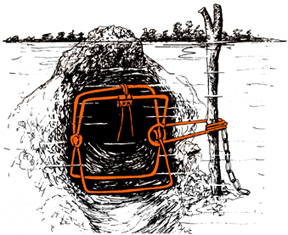
Conibear 110 trap set at entrance to den
Conibear traps No. 110 or 120, and foothold traps No. 1 or 1½ are those most commonly used for muskrats. Conibear traps may only be set in the water or in a well-used vertical slide and may not be used with bait or scents. Foothold traps may not permitted in certain game zones. Check with the SCDNR before purchasing or setting traps.
There are many effective sets for trapping muskrats. The underwater entrance to a bank den is an ideal place to set a conibear trap. Wading along the edge of the pond or stream and probing the bank with a stick can often locate entrances. Make the set so that the muskrat must pass through the trap in order to enter or leave the den. Sticks should be used to stabilize conibear traps by wedging them within the trap springs. If placed outside the spring mechanism, the sticks will impede the operation of the trap. Sticks and other materials placed around the trap site can help guide the animal through the trap so long as the trap function is not interfered with.
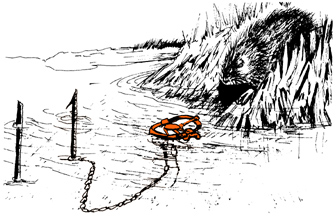
Trap set at end of slide
Foothold traps should be set for muskrats only where the animal will drown quickly. A trapped muskrat will head for deep water, and the weight of the trap will generally drown it. The trap should be chained to a stake driven in the ground in water at least 14 inches deep. A tangle or drowning stick driven near the trap stake will increase the effectiveness of the set. Foothold traps can be baited with a slice of apple or carrot on a stick over the trap trigger. Lures and scents are also effective.
Foothold or conibear traps can be placed at the bottom of a muskrat slide, just under the water. Slides are used over and over by muskrats as they climb into and out of the water. Muskrats also use runways through thick aquatic vegetation and muddy stream bottoms as they swim to and from feeding places. A trap set in the middle of the runway will often be successful.
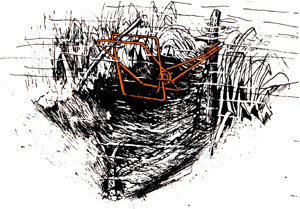
Trap set in muskrat run
One of the most effective trap sets where muskrats are destroying boat docks is the floating log set. Foothold traps are set in notches cut on top of a log, and the chains stapled or nailed to the bottom of the log. The set can be baited, but muskrats like to crawl up on a floating object anyway. When trapped, the muskrat will dive off the log and be drowned by the weight of the trap. It may be advisable to cover the top and sides with a wire covering (such as hardware cloth) to act as an “exclusion cage.” This helps prevent capturing non-target animals. The cage must extend out at least 10 inches on the side(s) where traps are located so that muskrats can enter by going underwater and resurfacing inside the cage. It is often necessary for several adjacent dock owners to work together because removing muskrats around just one dock may only be a temporary solution.
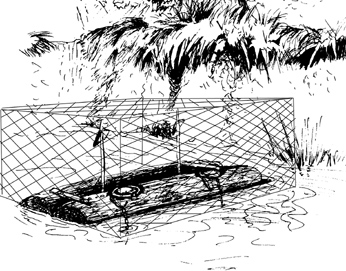
Floating log set (shown with exclusion cage)
There is usually some commercial demand for muskrat fur because of its soft, dense undercoat. Muskrats are relatively easy to skin, and pelts are worth about $2 each. Professional trappers may be interested in buying pelts or whole animals from landowners. Also, the dark meat is good to eat.
Muskrats are a natural part of a stable environment. Unless they are causing serious problems, total elimination from the area should not be considered. Furthermore, complete elimination of muskrat in a given area may require considerable trapping effort. Due to their high reproductive ability, 75% of a muskrat population can be removed each year without impacting the overall population in an area. Overpopulation can lead to disease and habitat destruction problems.
Information on
muskrats or other
South Carolina
furbearers can be
obtained by contacting:
S.C. Dept.of Natural Resources
Furbearer Program
P.O. Box 167
Columbia, S.C. 29202
(803) 734-3609
Written by Breck Carmichael,
Wildlife Biologist
Updated by Jay Butfiloski,
Wildlife Biologist
Edited by Victoria Buckingham
Illustrations by Bill Stroud
